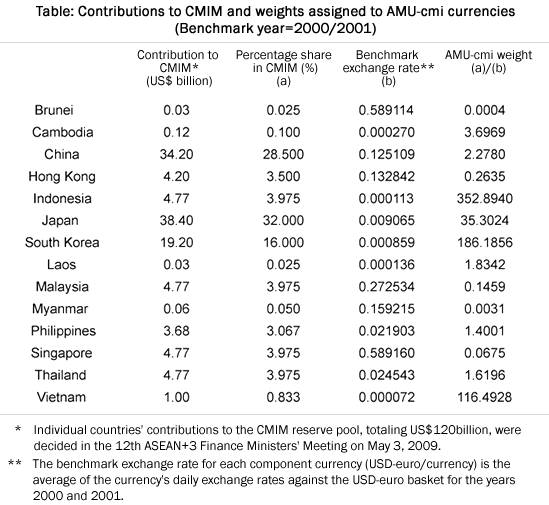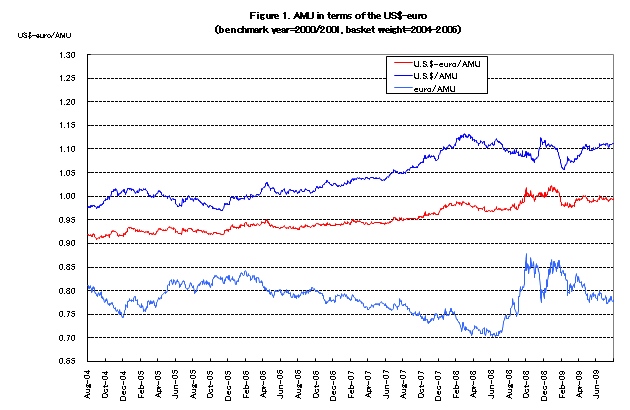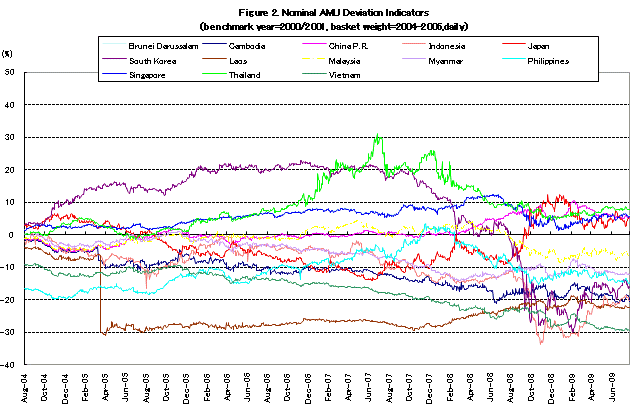Bipolarization of Asian currencies following the global currency crisis
The prevailing view in the summer of 2009 was that the world economy had finally hit the bottom and is on the road to recovery as massive fiscal and monetary measures in many countries have kicked in to put an end to the severe recession that began a year ago. However, very few believe that the recovery will be V-shaped. Most economists predict a gradual U-shaped or slower hook-shaped (Nike-shaped) recovery path. Many also point to the possibility of a double-dipped (W-shaped) recovery if the United States and Europe fail to clean up bad debt in a timely manner.
Amid the global recession, China and some other Asian economies were relatively quick to see green shoots of recovery. Earnings in the manufacturing sector, the prime factor contributing to the sharp decline in the economy, finally began showing signs of recovery. It is also expected that increasing consumption and investment in Asian economies will be a big plus to the world economy. Asian economies are increasing their presence.
Sharp falls in the prices of securitized financial instruments (many of these securities became worthless), which had been created and sold by U.S. and European investment banks and distributed to and held by a number of financial firms and investors around the world, are what sent the world economy into the severe contraction that has continued for the past 12 months (September 2008 - August 2009). Many financial firms were forced into (near-) insolvency with their capital depleted as a result of falling asset values. In the initial stage of the global currency crisis, financial firms and others moved to sell off their assets around the world and send money to their headquarters to help ease cash flow problems. This caused further declines in the prices of assets (such as stocks and real estate) all over the world and a significant change occurred in the trend of international capital flows. In the course of these developments, foreign exchange rates fluctuated greatly. The yen appreciated sharply against the U.S. dollar, whereas the euro and the currencies of resource-producing countries depreciated. For instance, prior to the crisis, the continuing build-up of yen carry trades kept the value of the yen lower than it would have been based on the state of the Japanese economy. Following the outbreak of the crisis, yen carry trades were unwound as financial institutions rushed to deleverage (i.e. unwind leveraged) investment positions and this contributed to the appreciation of the yen. Meanwhile, with global interest rates brought down to near-zero levels, spreads between Japan's ultra low interest rates and those in other countries were mostly eliminated, resulting in further appreciation of the yen.
In the latest global financial crisis, Asian financial institutions suffered relatively modest direct damage. However, they were significantly affected by fallouts of the crisis, with some institutions incurring huge losses as a result of volatile asset prices and the contraction of the real economy. Meanwhile, massive capital flights triggered by financial institutions and investors in the United States and Europe caused significant changes in the values of Asian currencies. While some changes were the correction of over- or under-valued exchange rates prior to the crisis, there were other changes that represented new developments in the aftermath of the global financial crisis.
We examined how the foreign exchange rates of Asian currencies changed during that period of time. First, let's look at how the Asian Monetary Unit (AMU), which is calculated as a weighted average of 13 East Asian currencies, changed against major international currencies, namely, the U.S. dollar and the euro. The figure below shows changes in the value of the AMU against the USD-euro basket,(note 1) the U.S. dollar, and the euro since April 2004. From this, we can see that the AMU exchange rate against the USD-euro basket has been remaining at or around 1 since the beginning of 2009, meaning that the AMU has returned to its level in the benchmark period of 2000-01. Meanwhile, the AMU exchange rate against the U.S. dollar has been hovering at or around 1.10 in recent months, maintaining a firmer tone in reflection of the yen's upward trend against the U.S. dollar since the outbreak of the crisis. In contrast, the AMU exchange rate against the euro, which rose from the pre-crisis level of 0.70 to 0.85 immediately after the Lehman shock in September 2008, has since fallen to below 0.80, indicating that the euro remains stronger than it was in the benchmark period.
Next, let's look at changes in the AMU Deviation Indicators that measure changes in each of the 13 East Asian currencies in its relative value against the others.
The above figure shows changes in the AMU Deviation Indicators from April 2004 to August 20, 2009. We can see that the trend of polarization of the East Asian currencies became obvious in September 2008 when the Lehman shock hit. Ever since, the deviations between strong currencies (Japanese yen, Chinese yuan, Thai baht, and Singapore dollar) and weak currencies (other East Asian currencies) have been sustained.
Such intra-regional exchange rate fluctuations have a significant impact on the real economy. Take, for example, the exchange rate between the Japanese yen and the South Korean won, which has been the most volatile among the inter-Asian currency exchange rates. Measured as the difference in the AMU Deviation Indicators for the two currencies, the won, which appreciated more than 30% against the yen in mid-2007, fell sharply from 2008 onward. As of August 2009, the yen has appreciated approximately 20% against the won. As a result, in the April-June quarter of 2009, South Korean electrical and electronics companies, the leading industry in the country, were able to recover to the pre-crisis level in their business performance, taking a commanding lead over their Japanese counterparts that are continuing to suffer from poor performance. Meanwhile, the Vietnamese dong, which continues to be pegged to the U.S. dollar, has weakened against the Chinese yuan, which gradually appreciated against the U.S. dollar following the July 2005 reform of the foreign exchange rate system. This resulted in a conspicuous tendency for Japanese companies to relocate their manufacturing bases from China to other Asian countries with a weak currency such as Vietnam (though it is needless to say that there are many other factors at work contributing to the deconcentration of production bases from China to other locations in Asia).
In August 2009, the Association of Southeast Asian Nations (ASEAN) and China signed the ASEAN-China Investment Agreement, a final pillar under the framework of the ASEAN-China Free Trade Area (ACFTA). The investment agreement, when it comes into force in January 2010, will complete the establishment of the world's largest FTA composed of developing countries. Given the need to prevent Asian countries from entering into a competitive devaluation race under this situation, and from the viewpoint of ensuring overall currency stability, it is expected to become all the more important to monitor inter-Asian currency exchange rates using the AMU Deviation Indicators.
Purpose of establishing data on AMU-cmi
The AMU was created in September 2005 under a joint research project of RIETI and Hitotsubashi University's Center of Excellence (COE) research program*1 as a regional currency basket of 13 currencies, namely, the currencies of the ASEAN 10 + 3 (Japan, China, and South Korea). The AMU Deviation Indicator is calculated for each component currency as the difference between the currency and the AMU. The creation of such an indicator was proposed under the Chiang Mai Initiative (CMI), a regional initiative agreed to in May 2000 that called for creating a network of bilateral swap arrangements (BSAs) in East Asia, as a tool for regional economic surveillance (mutual surveillance). The weight assigned to each currency in the AMU was calculated by using the arithmetic average of each relevant country's share in the intra-regional trade among the 13 member countries and its share in the region's total gross domestic product (GDP) measured at purchasing power parity (PPP) exchange rate, following the method used to calculate the European Currency Unit (ECU) under the European Monetary System (EMS). The calculation method has been subject to controversy and quite a lot of discussions have taken place to date.
At the 12th ASEAN+3 Finance Ministers' Meeting held in Bali, Indonesia, on May 3, 2009, measures for strengthening the CMI were proposed and the ministers agreed on the expansion of the reserve pool under the initiative to US$120 billion. They also agreed to implement the CMI multilateralization (CMIM) before the end of 2009. The CMIM requires economic surveillance specifically designed to monitor economic conditions and policies for their soundness and to address the financial needs once a crisis occurs. Against this backdrop, an economic surveillance unit is proposed to be established. Monetary cooperation in Asia will likely be further strengthened (which is congruent with the spirit of an Asian Monetary Fund, a concept proposed in 1997).
The CMI member countries have already agreed on individual countries' shares of contribution to the US$120 billion reserve pool for the multilateralized CMI or CMIM. We believe it is appropriate to use these shares of contribution to the CMIM reserve pool as composition ratios assigned to the individual component currencies in calculating the average value of a regional currency basket corresponding to the CMIM framework. For this purpose, we propose to create AMU-cmi as a new regional currency unit. It is expected that the AMU-cmi, which is similar to the special drawing rights (SDRs) of the International Monetary Fund (IMF) in concept, will be utilized as a reserve currency supplementary to the existing reserve assets of the CMI member countries or as a unit of calculation in the future. The AMU-cmi is different from the existing AMU in the following two aspects:
- Individual countries' shares of contribution to the US$120 billion CMIM reserve pool are used as their respective currencies' composition ratios in the AMU-cmi currency basket.
- The Hong Kong dollar is included as a component currency, reflecting Hong Kong's participation as a member of the CMIM.
Weights assigned to the individual component currencies of the AMU-cmi are calculated as below.(note 2)

Unlike in the original AMU basket, the Japanese yen is the largest component currency in the AMU-cmi basket with its composition ratio at 32%, followed by the Chinese yuan at 28.5%. However, combined with the Hong Kong dollar, China's composition ratio is 32%. Meanwhile, the composition ratio of the South Korean won in the AMU-cmi is 16%, higher than about 10% in the AMU basket. Japan, China, and South Korea together account for 80% in the AMU-cmi. The high ratios for the three North Asian countries reflect the current state of financial and economic conditions in Asia. In this regard, these countries need to play leading roles in regional cooperation in the coming years.





